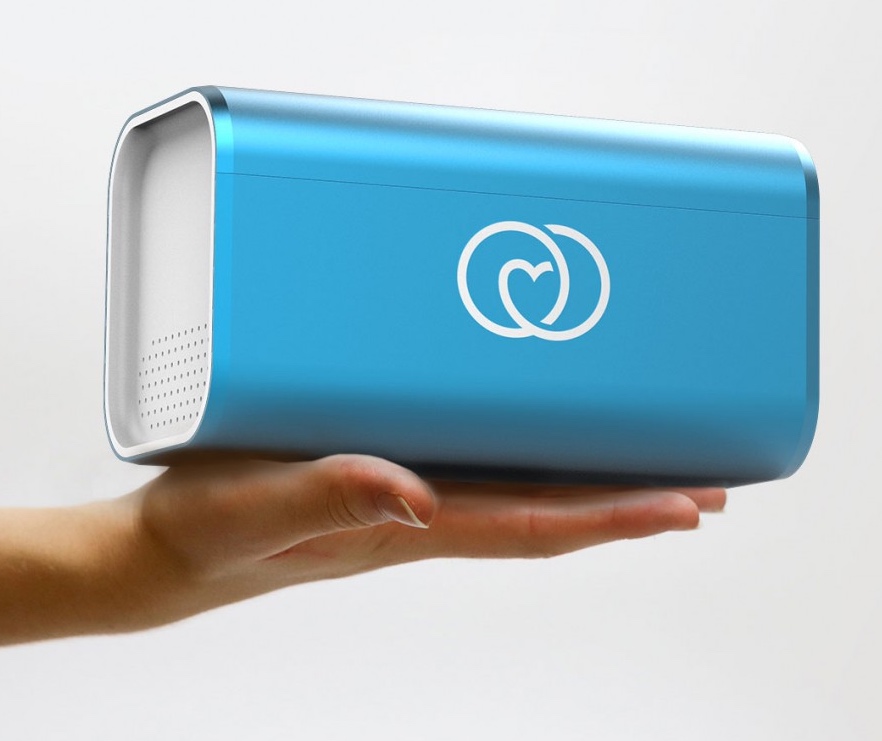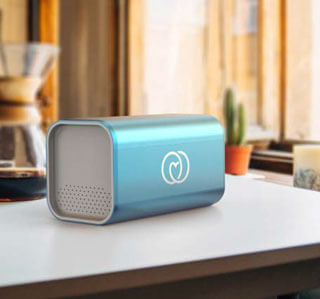
Travelling With Crohn's Disease
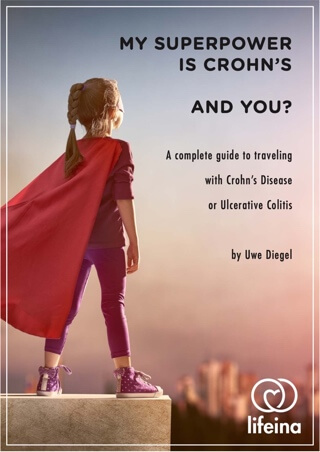
ABOUT THIS GUIDE
Everybody needs a vacation, but if you have Crohn’s Disease or Ulcerative Colitis (IBD), a holiday can be a reminder that you can’t ever get away from Crohn’s. Like it or not, you and your Crohn’s are travel companions. Fortunately, there are ways for you two to get along. Making sure you are prepared will help alleviate guesswork and stress and ensure that you relax and enjoy your trip.
People with IBD (inflammatory bowel disease) are exposed to two main risks during travel:
- Relapse (flare) of IBD due to gastrointestinal infections acquired during travel, change in dietary habits, forgetting to take your medication or unavailability of IBD medication.
- Acquiring infectious diseases common to developing countries, which may be more severe in IBD patients who are immunosuppressed.
This guide to traveling with Crohn’s and Colitis was developed by Uwe Diegel with a team of specialists and international medical consultants. We try to provide you with information that is factual and current. If you have any comments/suggestions/ questions about Crohn's, please login to our Facebook page www.facebook.com/medactiv.com.au (don’t forget to like us) or visit us on www.lifeina.com.au.
ABOUT UWE DIEGEL
Uwe Diegel (born 1965 in New Zealand), is a specialist in various forms of medical diagnostics such as blood pressure, temperature, asthma and diabetes. He is the holder of several patents relating to temperature and blood pressure measurement. Until the age of 26 he was a concert pianist. Following an accident that partially restricted movement in his right arm, he started a new career in medical diagnostics.
Serial entrepreneur, he entered the world of medical diagnostics in 1992, quickly developing a particular interest in cardiovascular diagnostics. His intense scientific curiosity has led him not only to develop new technologies in this field, but also to interest himself to field of medical manufacturing, industrial design and problems faced by Chinese manufacturing concerns.
 In 2009, Uwe gets interested in connected health as a means of providing better patient management. He becomes involved in iHealth, a platform that takes all the signals of the body and translates them into a meaningful format using smartphones and tablets. Uwe serves as CEO of iHealthLabs Europe until 2016. He leaves iHealth in 2016 to launch Lifeina, a company dedicated to developing new solutions for the safe transport of medication.
In 2009, Uwe gets interested in connected health as a means of providing better patient management. He becomes involved in iHealth, a platform that takes all the signals of the body and translates them into a meaningful format using smartphones and tablets. Uwe serves as CEO of iHealthLabs Europe until 2016. He leaves iHealth in 2016 to launch Lifeina, a company dedicated to developing new solutions for the safe transport of medication.
Uwe lives in Paris, France, where he runs HealthWorks Global and does fundamental research in blood pressure diagnostics. He is today considered to be a foremost expert in the field of blood pressure management and in the manufacturing of medical diagnostics devices.
Uwe Diegel has been at the forefront of international changes in healthcare technology for the last 30 years. His drive and passion for innovative technology have driven major changes in perception about healthcare. He has driven the manufacturing of medical devices to new horizons by forcing new practices in manufacturing and innovation. An internationally recognised expert in the management of cardiovascular disease and diabetes, he is continuously looking for better solutions to improve outcomes for patients. He has for the last few years spearheaded the dissemination and acceptance of connected health as a tool for providing better solutions for patients.

WHAT IS CROHN’S DISEASE
SO WHAT IS CROHN’S?
Crohn’s disease is an inflammatory bowel disease (IBD) in which an abnormal immune system response causes chronic inflammation in the digestive tract. Crohn’s is often confused with ulcerative colitis, a similar IBD that only affects the large intestine.
About 1.6 million Americans have inflammatory bowel disease. This figure includes about 780,000 people with Crohn’s disease and another 907,000 with ulcerative colitis. About 3 million Europeans suffer from IBD with a similar percentage between Crohn’s and ulcerative colitis. About 10 people per 100,000 people are diagnosed with Crohn’s disease every year.
WHAT CAUSES CROHN’S?
In Crohn’s disease, the immune system mistakenly attacks healthy bacteria in the gastrointestinal tract. Chronic inflammation causes thickening of the intestinal wall, which triggers the symptoms. The exact reason this occurs is not clear, but there is a hereditary factor. According to the Crohn’s & Colitis Foundation of America, between 5 and 20 percent of people who have an IBD have a first- degree relative with one. The risk is higher in Crohn’s than ulcerative colitis, and higher when both parents are affected.
There may also be an environmental element. Rates of Crohn’s are higher in developed countries, urban areas, and northern climates. Stress and diet may worsen Crohn’s, but neither is thought to cause the disease. It is likely that Crohn’s is caused by a combination of factors.
WHO GETS CROHN’S?
Anyone can develop Crohn’s disease or ulcerative colitis. However, IBDs are usually diagnosed in young adults between the ages of 15 and 30. Children are twice as likely to be diagnosed with Crohn’s as ulcerative colitis. Boys develop IBDs at a slightly higher rate than girls.
Inflammatory bowel disease is more common in Caucasians than African Americans, Asians, Hispanics, or American Indians. However, the rate of diagnosis in African American patients is on the rise, approaching the same rate as in whites. Ashkenazi Jews are at higher than average risk of Crohn’s disease.
In general, people who live in higher latitudes are more likely to develop Crohn’s than those in lower latitudes. When relocating from a low- latitude to a high-latitude region, the risk of developing Crohn’s matches that of the high- latitude region within a single generation.
SYMPTOMS OF CROHN’S
Symptoms of the disease vary from person to person, depending on the type of Crohn’s. The most widespread form is called ileocolitis, which affects the end of the small intestine (ileum) and the large intestine. Symptoms include pain in the lower or middle part of the abdomen. Diarrhoea and weight loss are common. Ileitis affects only the ileum but causes the same symptoms.
When Crohn’s affects only the colon, it is called Crohn’s granulomatous colitis. This type of Crohn’s causes diarrhoea and rectal bleeding. Patients may develop abscesses and ulcers in the area of the anus. Other symptoms include joint pain and skin lesions.
Other general symptoms of Crohn’s include fatigue, fever, and night sweats. Some patients experience an urgent need to move their bowels. Constipation can also be a problem. Women may have an interruption in their menstrual cycle. Young children may have delayed development.
Most Crohn’s patients have episodes of disease activity followed by remissions. The stress of a flare-up can lead to anxiety and social withdrawal.
A FEW CROHN’S STATISTICS AND FACTS
- It is estimated that between 5 and 20 percent of Crohn’s sufferers have a first-degree relative who also has the disease.
- Inflammatory bowel disease is usually diagnosed in young people between the ages of 15 and 30.
- Boys are more likely to develop IBD than girls, although Crohn’s disease affects males and females equally.
- People living at higher latitudes are more likely to have Crohn’s disease than those who live at lower latitudes.
- With appropriate treatment, around 50% of Crohn’s patients will have only mild disease symptoms or be in remission after five years.
- More than 200,000 hospital admissions were reported in the USA due to Crohn’s disease in 2015.
- The cost of treating a Crohn’s patients for a year is an average of $10000.
- Eleven percent of Crohn’s patients will experience severe disease activity.
- Smoking doubles your risk of developing Crohn’s disease.
- Caucasians and Ashkenazi Jews are more prone to the disease.
7 FACTS AND FICTIONS ABOUT CROHN’S DISEASE
There are a lot of urban legends regarding Crohn’s disease, it’s treatment and how to live with it. Every person who suffers from Crohn’s disease is different... There is no “universal” approach that suits all patients. Chronic inflammatory bowel disease (Crohn’s) varies greatly from person to person.
Please do not rely on urban legends when taking care of your health, and always listen to the advice of your healthcare professional.
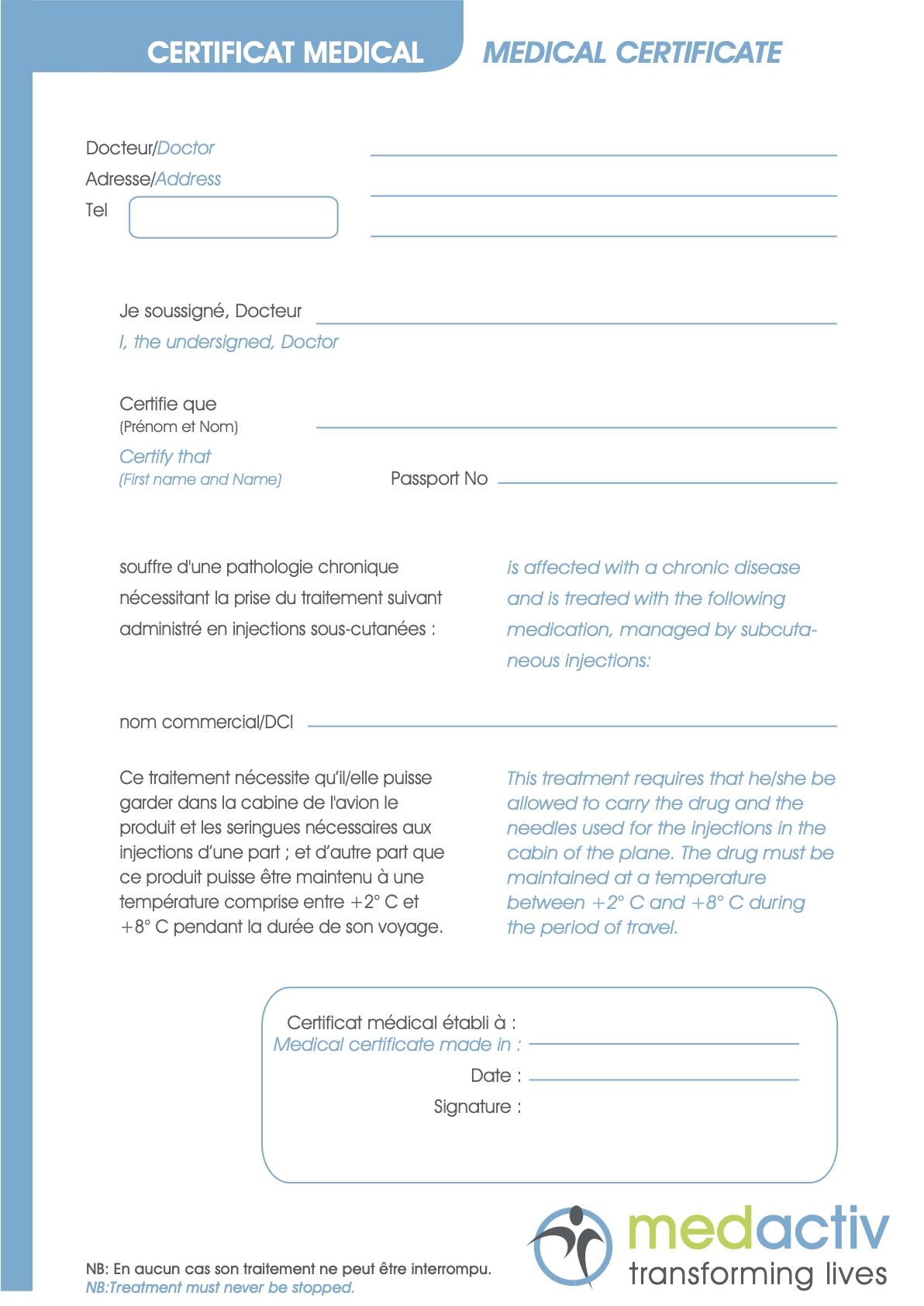

WHAT TO PACK - THE CROHN’S SURVIVAL KIT
In case of emergency, here are some things you’ll want in your carry-on bag:
- prescription medications in their original bottles
- over-the-counter antacids and antidiarrheals
- disposable tissues and moist wipes
- hand sanitizer
- a change of underwear and outfit
- nutritional supplements
- meal replacement bars
THE BASICS
A couple of other important things to consider before you travel:
- Remember to take your meds on schedule.
- Be sure to include a list of contact information for doctors, hospitals, and pharmacies located in your travel destinations and at home.
- Bring photocopies of your medical chart, prescriptions, insurance cards, passport, and driver’s license.
- Check with your doctor to learn whether or not you need any immunization shots and buy travel insurance to cover sudden health issues.
- If you don’t own a portable electronic translator, do a little homework and learn how to say “doctor,” “hospital,” “pharmacy,” and other potentially life-saving terms in the language of your destination.
- Get an international lexicon of brand name and generic IBD medications.
TALK TO YOUR TRAVEL AGENT
Tell your travel agent that you have Crohn’s or IBD and explain the specific requirements that the journey might entail. This way, your trip can be tailor-made to better meet your needs. A missed connection in an airport can ruin even the best-prepared holidays. When you book your plane or train trip, choose an aisle seat next to the lavatory for the sake of convenience.
TALK TO YOUR DOCTOR
Consult with your doctor before planning/ confirming your holidays. Discuss your itinerary with him and develop plans for meals and medication, especially when traveling through different time zones. Ask your doctor what to do in the eventuality of you becoming sick while on holiday.
TRAVELING WITH CROHN’S...
VACCINATIONS
As with any travel plans, always make sure that you have the relevant vaccinations and medication. Always speak to your doctor in good time (about 4-6 weeks before the planned journey). If you decide to use an independent travel clinic, always tell the doctor about your condition. If you are being treated for IBD, you may also need vaccination against the following diseases, depending on the destination of your journey:
- Yellow fever
- Hepatitis A
- Hepatitis B
- Cholera
- Rabies
- Meningococcal encephalitis
- Japanese encephalitis
- Tuberculosis
However, if you are using steroids, immunomodulators or biologic therapies for your ulcerative colitis or Crohn’s disease, you should avoid some vaccines (against yellow fever, cholera and tuberculosis) as these medicines may affect the ability to react to the vaccines. Always consult your doctor to find out what vaccines will be suitable for you.
TRAVELING WITH AN OSTOMY
This goes without saying but be sure to pack all your supplies and then some.
Pre-board the train and get the best seat. Finding the right seat can make a world of difference on a train. Just tell them you have a medical disability and show them your medical alert card and it’s not an issue. Make sure to get a seat by the bathroom and that you are comfortable before anyone else gets on.
If you’re traveling by airplane try to select your seat ahead of time. If you want to sit closest to the bathroom or need an aisle seat so you can get up fast and easily make sure to get that set up!
SOME MORE TIPS
- It is better to travel when your IBD is stable. This will prevent the risk of a flare-up and also reduce your insurance premiums.
- Always ensure you have adequate travel insurance to cover your IBD.
- Obtain a letter from your specialist outlining your medical history and medication.
- Consider your travel destination. A backpacking trip around Burma will carry different risks and need more preparation than going to America. Take into consideration your current health and the facilities available in the country you are visiting.
- Need vaccinations before your trip? You may need these up to 8 weeks before you travel so plan ahead and visit a travel clinic. You may also be taking medication that prevents you from having some vaccinations.
- Ensure you take an adequate supply of medication with you.
- Always pack a sunscreen to protect from UVA and UVB rays. Some medication used in IBD such as azathioprine or mercaptopurine can make your skin more sensitive to the sun and therefore sunscreen is even more important to prevent the risk of skin cancers.
- If you are on medication that needs to be kept cold, does your accommodation have an in- room fridge?
- Choose accommodation to suit you. Does it have a private or shared bathroom? If shared, is the bathroom on the same floor?
- If stress makes your symptoms worse, then plan your trip to be as stress free as possible. A busy itinerary may sound great, however you may feel so exhausted that you cannot enjoy your trip.
- Escorted or independent travel? A tour may save time and worry of making arrangements. The tour leader will know how to access medical care and where the toilets are.
- Working abroad? If you plan to do welfare work in developing countries you may be at higher risk of some infections. This should be discussed with your IBD team/ travel clinic.
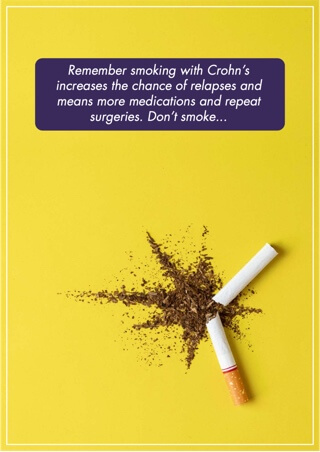
TRAVEL INSURANCE
Make sure you have travel insurance to cover your trip and keep copies of your insurance docs with you in case of emergencies. Before you travel, ensure that your travel policy is adequate and will cover your IBD-related problems. Unfortunately, many insurance policies exclude cover arising from pre-existing illnesses and will probably refuse claims. So make sure that your travel policy offers full cover. You may also have to confirm that you are not travelling against your doctor’s advice.
CROHN’S IN A FOREIGN LANGUAGE
Learn how to say, “I have Crohn’s Disease” and “Where is the toilet?” in the language or languages of the countries you visit. Try to find out what the important words for Crohn’s are in the country where you travel in case you have a medical emergency or if you need to let people know that you suffer from Crohn’s.
FOOD, FOOD, GIVE ME FOOD!
Pack a temptation survival kit. There’s limited evidence that foods actually cause Crohn’s disease. But for people with Crohn’s, certain foods like high-fat items and dairy products can make symptoms worse. Of course, staying away from all the butter, cream sauces and fried foods around the holidays can be a major test in willpower. To help, take along your own “indulgent” foods or dishes that you know won’t aggravate your symptoms. (It may be a good idea to let your party host know that you have a special diet and will be bringing some of your own holiday favourites). It will help you feel like you’re getting a treat without giving in to all the holiday temptations.

FOOD, FOOD, OH GLORIOUS FOOD...
Browse the buffet. Chestnuts may be roasting on an open fire, but that doesn’t mean you want to add them to your plate. High-fibre foods are especially rough on the digestive system for those with Crohn’s, so it’s a good idea to survey the playing field. If you’re up against a holiday buffet, you may want to avoid foods in the cabbage family, such as broccoli and cauliflower, as well as nuts, seeds, corn and popcorn. If raw fruits and vegetables bother you, try steamed, baked or stewed options instead.
Nibble your way through. Sitting down to a big holiday meal is a big no-no for people with Crohn’s. Eating small, frequent meals (five or six per day) is the best way to keep symptoms at bay, but it doesn’t mean you have to avoid the family holiday table. Before the big feast, be sure to snack on appetizers or other foods so that when you sit down to eat, it’s easier to graze or nibble on a few choice items, rather than filing yourself up and fuelling those symptoms.
Toast in moderation. Holiday partying typically means holiday drinking, but for some people with Crohn’s, this can mean a sure-fire flare-up. And alcohol can potentially cause complications if you are on certain medications. Have a discussion with your doctor; with a little trial and error, and a better understanding of your limits, you may still be able to imbibe during the holidays. But if you know alcohol is a problem for you, try some hot cocoa or mulled apple cider to get in the spirit.
Fill up on H2O. Drinking plenty of fluids can help with Crohn’s symptoms, but certain fluids can make things worse. Drinks that contain caffeine stimulate your intestines and can make diarrhoea worse. Carbonated drinks often produce gas. Choose water instead or have a glass or two in between the occasional soda or coffee beverage. Extra water can also help wash and water down those spicy and other potentially troublesome foods.
RESTAURANT SURVIVAL GUIDE
If you have Crohn’s disease, you have to be picky about what you put in your mouth, and going out to eat may be a challenge—particularly if you’re having a flare-up. However, if you do feel up for eating out, check out these 8 tips to avoid aggravating a flare-up and make the most of your dining experience.
STUDY THE MENU
Search online for the restaurant menu. And don’t be shy about calling the restaurant. Many restaurants will modify their dishes, swapping heavy cream for low-fat milk in their soup or mashed potatoes, for example, especially if you ask them ahead of time.
KNOW YOUR TRIGGERS
Although food tolerances are different for everyone, certain food groups are common problems: dairy products, fatty foods, and raw fruits and veggies. On the other hand, sandwiches with lean meat like turkey (and avocado instead of lettuce and tomato), or well- cooked foods like mashed potatoes, rice, and veggies tend to be better tolerated.
EXPLORE COOL CUISINES
Certain cuisines tend to be better tolerated than others. Spicy foods like Indian or Mexican usually do not go down as well as blander meals. Japanese food like miso soup, sticky rice, or salmon can be good choices.
BRING YOUR OWN FOOD AND SNACKS
Driving and road tripping can make you hungry. It’s always nice to snack on something. But you do not want to eat the sugar loaded, fat and old food at gas stations or roadside diners. It’s better to bring your own food and snacks. This way, you’ll know what you put in your mouth and how your body reacts to it. Don’t know what to bring? Consider nuts, dried fruits, granola, rice crackers or oat cookies. Basically, anything that you know works for you.
CHANGE YOUR EATING PATTERN
If you’re not comfortable travelling and you’re constantly anxious about finding a toilet, you don’t want to add more stress. You might want to consider changing your eating pattern for the duration of the road trip. Slowing down the digestive system or shutting it down completely, might prevent you from rushing to the toilet and helps you survive a road trip with Crohn’s disease.
EAT FOOD THAT IS LIGHT ON THE DIGESTIVE SYSTEM
Don’t eat a heavy meal or a hearty breakfast right before your road trip. You want to be gentle for your intestines and give them as little work as possible. Drink plenty of water and bring a water bottle with a filter to avoid catching any bacteria. Don’t let people put ice in your drink and avoid ice cream.
If you really want to shut your system down, to avoid the dreaded #2 on the road, consider only taking fluid nutritionals. You can start with this 12 hours before your road trip. You take large amounts of clear broth, tea, cranberry juice and other light juices. Consider Jell-O and popsicles. This will keep you hydrated and nourished on your road trip. Don’t eat a big meal the minute after you arrive, but continue with the liquids for half a day longer.
DRIVING AND CROHN’S
It’s complicated to do long driving stretched with Crohn’s. Sitting in the car for multiple hours in your tight jeans will leave a mark on your legs and belly. You do not want your tight belt buckle to hit your stomach with each bump in the road. Maybe your bum is hurting from the last toilet visit. Make sure you wear comfortable clothing, like sweatpants or linen trousers in summer.


ON THE ROAD AGAIN !
Maybe even bring a donut to sit on, to relief the pressure from your butt. Anything to make you more comfortable and survive a road trip with Crohn’s disease.
PLAN YOUR TOILET STOPS
Research the toilet stops along the way. Travel with your own toilet paper. You cannot count on toilet paper being provided at your toilet stop. The facilities might not be as clean as you’re used to, so make sure to bring your own products. Also take wet wipes or nappies and some hand sanitizer, just in case. Take the things you need and kept them close at hand during your road trip.
If you experience any gastric distress like fever, chills, dizziness, abdominal pain, or bloody stool, you should find a bathroom immediately. Otherwise, the condition may get worse.
Before traveling, learn how to translate words like “toilet,” “urgent,” and “emergency” in the language of your destination. Whether you’re sightseeing on foot or on wheels, do yourself a favour and take time beforehand to locate public restrooms along your route.
TAKE BREAKS
It’s tempting to put the pedal to the metal and drive as quickly as possible (or allowed). This way, you’ll reach your destination as soon as possible and you’ll be safe. However, taking breaks is important. Put the car aside and take some fresh air. Walk around and get some exercise to avoid constipation. This way, you’ll be able to concentrate again and be a safe driver and survive a road trip with Crohn’s disease.
BECOME A TOILET EXPERT...
Know where the restrooms are. All that drinking and eating is bound to have an effect on your system. If you’re doing a lot of partying or traveling during the holidays, be sure you know where the restroom is located at all times, in case of an emergency. Depending on your symptoms, you may also want to pack a travel bag with wipes and a change of clothes.
Go to the restroom frequently. Holidays can involve long stretches of travel whether by air or ground. Experts recommend taking frequent bathroom breaks during layovers and gas station stops, as a full bladder may irritate the GI tract. A good rule of thumb is to go to the bathroom every chance you get, because your next opportunity may be many hours later.
Take a nice brisk walk. Even mild exercise, like a stroll through the snow, can help reduce stress, relieve depression, and help with bowel function. If the winter weather outside is frightful, try some other form of exercise, like yoga in your living room or a class at the gym. Ask your doctor about the best exercises for you.
DOWNLOAD THE SITORSQUAT APP
Sitorsquat is a mobile app which maps many public restrooms across the globe. They will find a toilet near you if you’re in need.
AVOID TRAFFIC JAMS
There is nothing more nerve racking than getting stuck in a huge traffic jam. Slowly the cars in front of you come to a stop and you’re stuck. Avoid the stress of being stuck in traffic and take a detour when the option presents itself. Or better yet, stop at the first gas station or diner and take a break. This way, you’ll be close to a toilet and you do not have to worry about having to go when you’re stuck in traffic.

ACCEPT COMPANY
If somebody offers to drive along with you, take the offer. It’s better to drive with 2 or more people than on your own. Especially when you have severe flare ups and you’ll experience heavy stomach pain. It’s not responsible to drive when your stomach is having you fold over the steering wheel in pain. You can take turns driving, which isn’t so exhausting, and they can distract you with conversation. Traveling together can help you survive a road trip with Crohn’s disease.
BRING CHANGE
Going to the toilet in public facilities might costs some bucks. You might need to donate a small fee, or the doors won’t unlock unless you have the proper change with you. You do not want to have to run back to the car or ask strangers for the right amount of change when you’re in need of a loo urgently. Bring enough coins and save up all your change. Make sure to go to the toilet before you buy your coffee to go.
SKIP THE LINE
Having a medical disability allows you to skip the long process of going through security at the airport and you can use the priority line. If you can’t wait in long lines due to pain, urgency, or anything else that makes it a challenge, you can ask the person standing at the entrance of the line if there is a special line for people with a medical condition. Don’t forget to stand up for yourself. They can’t say no! Having a medical alert card or note from your doctor helps.
DON’T SMOKE
If you’ve quit smoking or are trying to quit, the holidays, with the hectic pace and endless family functions, can bring on the urge to pick up a cigarette. But smoking with Crohn’s can increase the chance of relapses and mean more medications and repeat surgeries. Plan ahead for those tension-building moments with a back- up strategy. This could be taking a walk around the block, popping a stick of gum, or calling a friend who knows how to talk you through the latest family squabble.
BE COOL...
Keep your cool. Like food, stress has also been shown to aggravate Crohn’s symptoms. And while your holiday calendar may look like you’ve recently won a popularity contest, you don’t have to succumb to the chaos. Choose the gatherings and outings that mean the most to you, and try to prioritize the events that you know will be relatively stress-free. Don’t be afraid to say, “No, thank you.” Let friends and family members know that you need to scale back your social calendar this season for your own health and well-being.
DON’T FORGET YOUR MEDICATION
Of course, you’ll need your meds. If it’s just a day trip or a multiple day road trip, make sure you bring your medication. Don’t forget to pack them, but also keep them close at hand. Your medication is no good to you hidden at the bottom of your suitcase and stuffed in the trunk of your car. Especially when you absolutely need them, like now!
Make sure you have enough medicine to cover the entire period of your trip. It may also be a good idea to double the amount of medication you need for your trip and to put one set in your hand luggage and the other in the hand luggage of your travel companion. That way you’ll have a backup if you happen to lose one of your bags during the trip. Keep your medications in properly labelled containers, as issued by your pharmacist, and keep your medication at the right temperature (between 2 and 8°C).
Make a list of your medications ahead of time and check and double check that you have them all. It also helps to know of pharmacies in the area and if you are able to get any of your medications you may have forgotten while you are away. If you are going on very long trips (study abroad, etc.) you might need to have infusions done somewhere else or have injections sent to you. Discuss how you might arrange this with your doctor.
Make sure that you have some of your medication in your carry-on. Take extra supplies and medicines in case of loss or theft. Include any other supplies you might need, including food, drinking water, and medication against nausea and diarrhoea.
BRING A SCARF
Bring a large scarf or sheet when you go on a road trip. It comes in handy when you’re in the middle of nowhere and there isn’t a toilet in sight. And there isn’t anything else in sight either. With a scarf or a sheet, you can build some sort of privacy corner when you have to go do your business. This way, you’ll have a little bit of privacy and you do not have to show your bum to all the other cars passing by.
PRESCRIPTIONS AND TRAVEL CERTIFICATE
Ask your doctor to give you a prescription in English, because English is the most widely understood language by doctors worldwide.
Download a travel certificate and ask your doctor to complete it. This travel certificate says that you have IBD and that you should not be separated from your medicine, and that this medicine should be stored at a temperature between 2 and 8°C. You can print the Travel Certificate that is included in this guide on the MedActiv website here.
EUROPEAN HEALTH INSURANCE CARD (EHIC)
If you are European and traveling in Europe, this card will entitle you to free or low-cost healthcare in most European countries. The EHIC card is free and is available on the French health insurance website (https://assure.ameli.fr/).
ASSISTANCE
When booking, always inform your airline or your travel agent if you need assistance during the trip.
COPIES OF YOUR PRESCRIPTIONS
Make copies of your prescriptions and keep them in your hand luggage in case customs or airport security ask you questions about the medications you are carrying.
CUSTOMS
- Inform the security guards that you have Crohn’s and that you are carrying medical supplies. Your medication must have a prescription label with your name on it.
- All medications must be labelled with the manufacturer’s name.
- Syringes are only allowed through security if you are carrying medication.
If you are taking medication, do not forget to take it with you at all times. Security scanners used during check-in will not damage your medication. However, if your luggage is under X-rays for a longer period than normal, or if the luggage is X-rayed several times, your medication may lose some of its effectiveness. So if possible, it is always better to ask them to pass your medication through manually. Again, if you warn the security guards BEFORE they ask any questions, they will normally bend themselves backwards to help you. You’ll probably end up jumping the line and getting through before everyone else. However, if you are a jerk about it, you could end up getting that dreaded full cavity body search.
WHERE TO PUT YOUR MEDS ON THE PLANE
Generally, the luggage zones on a plane are all pressurized and maintained at a constant temperature of about 5°C. This is a standard for the vast majority of airlines. So it’s not a problem for you to put some medication in the hold. However, if you are using an unusual flight (for example in the steppes of Russia with a Russian ex-military aircraft), please note that your luggage might be in an unpressurized environment and will be at a low temperature that is likely to freeze your medication. Crohn’s medication is affected by extreme temperatures and should never be stored in an unpressurized aircraft. It is important to inspect your medication before each injection. If you notice anything unusual with its appearance, immediately replace it with fresh medication. Medication that has been frozen will look like it has crystals in it. These crystals are super uncomfortable to inject.
Generally, it is recommended never to leave your medication and, if possible, to carry it as hand luggage, because if it is in your main luggage in the hold and that your suitcase is lost, it may ruin your vacation. Wherever you go, always keep enough meds for the duration of the trip and one day more.
TIPS FOR DIFFERENT TYPES OF TRAVEL
BY PLANE
Be sure to give yourself extra time before your flight because when you arrive at the security check with medication and syringes, the security control of the airport may take a few minutes more.
Airlines usually offer special meals for anyone who asks (however you must notify them at least 48 hours in advance), but with a little planning, the regular meals in an airplane can normally fit into your usual diet. Always have appropriate snacks with you in case your flight or the meal is delayed, or if the meal provided is not suitable. Be aware of time zone changes and of the timing of your meals and prepare your medication accordingly. If you sleep during your flight, use an alarm clock or ask the flight attendant to wake you up at meal times or when it is time to take your medication.
Try to stay active during your trip: walk through the terminal before boarding, do simple stretching exercises in your seat or make circles with your ankles. If possible, elevate your legs every now and then.
If you are using a prescription drug it is important to have it with you and to know how to use it and any side effects that you may have. This will help you in explaining to the flight attendant how to help you if you need it.
After a long flight, try to relax for a few days to get your system back in shape. Plan your activities so that you can integrate your medication and meals in your average day.
BY CAR
Whether you are a driver or a passenger, stop every few hours to stretch your legs and do some physical activity to improve circulation in your legs. Keep your medication, meals and snacks as regular as possible. Remember that if you are stuck in a traffic jam, car breakdown, or take wrong directions, it will not always be possible to find a rest room.
BUS TRIPS
- Ensure there is a toilet onboard, especially for long trips.
- Request an aisle seat where possible
BOAT TRIPS
Cruise liners are known for their extravagant buffets. Don’t go overboard (ha ha ha, excuse the pun) ... With such a wide variety of appetizers and dishes available, it is easy to overindulge. If possible, try to get a sample menu of the cruise and you’ll then have an idea of the types of food served and will be able to plan your meals accordingly.
Stay active to compensate for any extra food you eat. Cruise ships offer a wide range of activities; try an aerobics course, swimming, or just have a romantic stroll on the deck at sunset.
It’s always a good idea to make the cruise staff aware of your Crohn’s in case of problems.
TIME ZONE CHANGES FOR MED USERS
Long trips often cross several time zones, so a 24-hour day may be extended or shortened depending on your direction of travel. You should adjust your medication schedule accordingly. Your control may be disturbed by a change in schedule, modified activity, or a disturbance in your sleep patterns.
If you cross more than two time zones, you should prepare a schedule of meals and medication together with your doctor.
DON’T DRINK THE WATER
Avoid tap water in developing countries. This includes ice cubes made from tap water.

ALCOHOL, CROHN’S AND TRAVEL
Travel is often equivalent to a holiday where alcohol consumption might be higher than usual. To reduce this risk, take the following steps:
BEFORE DRINKING ALCOHOL...
- Eat regular meals and take your medication.
- Know where the closest toilet is.
WHILE DRINKING ALCOHOL...
- Always mix your own drinks. Use less alcohol and stretch your drinks with sugar-free mixers.
- Drink slowly. Between each glass, have a drink without alcohol.
- Know where the closest toilet is.
AFTER DRINKING...
- Tell a responsible person that you’ve been drinking.
- Get up on time the next day for any food or medication that you normally take.
- Know where the closest toilet is.
IF YOU BECOME ILL WHILE ON HOLIDAY
During periods of illness, it is VERY IMPORTANT to:
- Call your doctor or go to an emergency room if you vomit and/or have diarrhoea twice or more in less than four hours.
- Relax.
- If you have travel insurance, take your documents with you to hospital.
THE STORAGE OF YOUR MEDS
Your Crohn’s or IBD medications are fragile and must be stored properly, because they will quickly become less effective if they are exposed to extreme temperatures. If your meds are exposed to temperatures below 0°C or are frozen, they almost immediately develop crystals that make the injection dangerous and uncomfortable. The ideal storage temperature for your meds is between 2 and 8°C. At this temperature they can be maintained almost indefinitely.
TRANSPORTING YOUR MEDICINES
MedActiv and Lifeina have developed a range of solutions to keep your Crohn’s and Colitis medicines at the right temperature at all times. These solutions are divided in two major technologies, which are cooler bags and mini fridges.
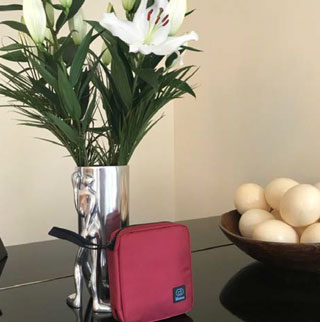
LifeinaBag medicaton transport bags are discrete and offer protection of 24 hours between 2 and 8°C.
ICOOL
The iCool bags use a new generation of chemical ice packs that do not sweat and have a longer thawing point than traditional ice packs. The iCool bags can keep medication between 2 and 8°C for up to 36 hours, depending on the model chosen. They also include separate compartments for transporting your accessories. Available under both the MedActiv (iCool) and the Lifeina (LifeinaBag) brands, these bags are the perfect companion for longer trips.
LIFEINABOX
LifeinaBox is the world’s smallest intelligent fridge for the safe transport of fragile medications. Connected to an application that monitors the temperature of your medication, and with a built-in 6-hour battery, LifeinaBox is truly the best possible example of Human Centred Design.
USEFUL HINTS
For environmental reasons, more and more hotels are using coded cards to open the doors of their rooms and these cards are also often used as a switch to turn on and off the electricity in the room. This means that when you leave your hotel room, you take your card with you and turn off all the electricity in your room (including the little bar fridge where you keep your medications cool). To work around this problem, just use any old plastic card (a gym membership card, business card, etc.) to switch on the power in your room. Leave it permanently in the room so that the electricity stays on.
If you need to freeze the ice packs of your travel bag before leaving the hotel, the refrigerators in the hotel rooms are generally not of a very good quality and will not completely freeze your ice packs. So instead of using the bar fridge in your room, go down to the hotel bar and ask the helpful staff to freeze them for you. After all, they always need ice in bars to make those delicious gin tonics and therefore have high quality freezers.
USEFUL SITES
European Health Insurance Card
Google translate
MedActiv (transport solutions for medication)
Lifeina (the world’s smallest fridge for transporting medication)


ABOUT LIFEINA !
Lifeina is an innovative startup that aims to be a global leader in the development of transport and storage solutions for sensitive medication. Our products are designed to give users the freedom to travel knowing that their medications are kept at exactly the right temperature.
The Lifeina solutions are specially designed to bring added value to the medications they are made for. Strategically located in Paris, we have the reputation of always anticipating the needs of our customers with an approach that is based on the total satisfaction of the end-user of the medication.
Our team of experts includes physicians, patients and engineers who are dedicated to finding better solutions for the transport and storage of sensitive medication.
EXCEEDING YOUR EXPECTATIONS FOR THE TRANSPORT AND STORAGE OF MEDICATIONS
For Uwe DIEGEL, creator of Lifeina, the company represents a personal investment. “In 2003, my brother almost died following an incident where his medication was accidentally frozen in a hotel. So I started this company because of reasons that are more of a personal nature than just business. Lifeina is for me the ultimate expression of innovation at the service of healthcare. If the Lifeina products are so popular, it is because they are designed by patients for patients and because we speak directly with users of the medications to really understand their needs. “
THE LIFEINA MISSION
Lifeina challenges benchmarks in the thermo- sensitive medication sector. We manufacture and market innovative solutions for the storage and distribution of thermo-sensitive medications.
THE LIFEINA VISION
A future where users of medication are not hampered by intrinsic limitations dictated by their health condition. A future where users are allowed the freedom to take responsibility for their health by using the correct tools for health management.
For more information, please contact:
Lifeina SAS
6 rue de Castellane 75008 PARIS, France
Tel. +33 (0)1 42 66 15 59 hello@lifeina.com www.lifeina.com
Lifeina Australia
contact@lifeina.com.au
www.lifeina.com.au
BON VOYAGE !
ABOUT MEDACTIV
MedActiv is a global leader in the development of transport and storage solutions for sensitive medication. Our products are designed to give users the freedom to travel knowing that their medication is kept at exactly the right temperature. As the chosen partner of major pharmaceutical companies worldwide, MedActiv is constantly pushing back the boundaries of this industry.
MedActiv North America www.medactiv.ca MedActiv Europe www.medactiv.com MedActiv South America www.medactiv.cl MedActiv Australia www.medactiv.com.au
© 2023 Medactiv Australia - All rights reserved.
Unauthorised duplication or publication of any materials from this Site is expressly prohibited.
Unauthorised duplication or publication of any materials from this Site is expressly prohibited.

